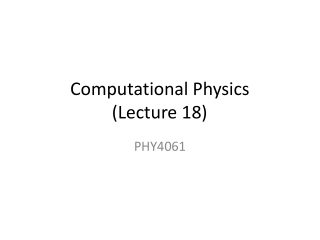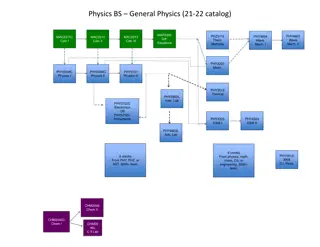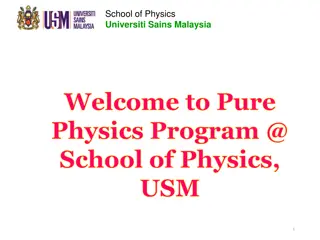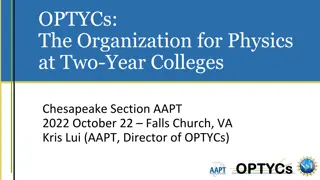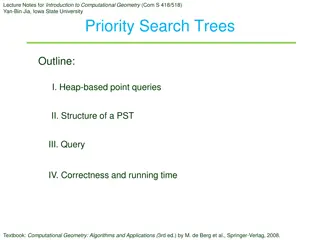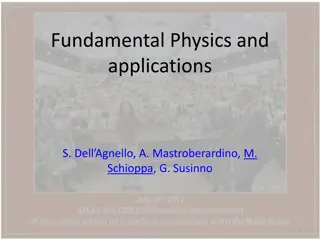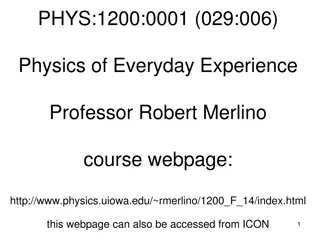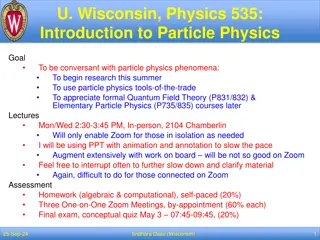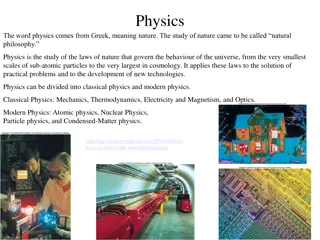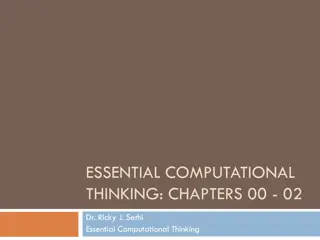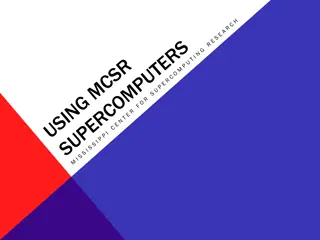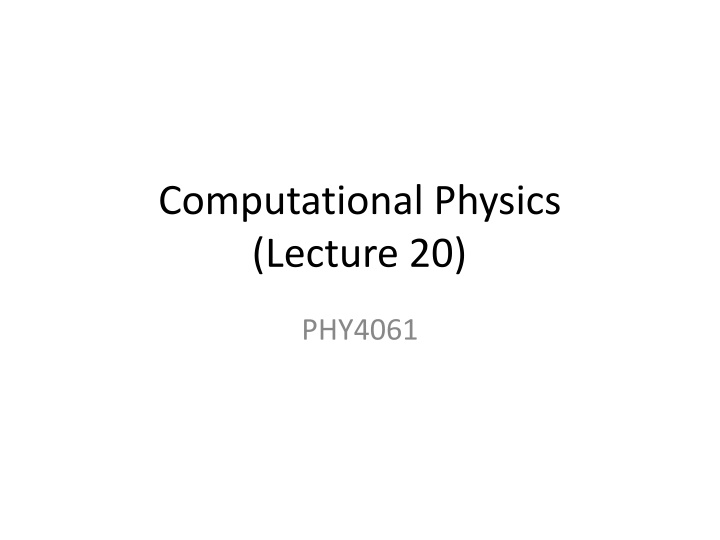
Principles of Parallel Computers and Architecture Overview
Explore the advancements in parallel computers and architecture principles, including the development of massively parallel processors in the 80s. Understand the impact on programming models and the evolution from unified global memory to distributed memory systems. Dive into the efficiency of parallel algorithms tailored to specific needs and the effectiveness of vector processing for intensive applications.
Uploaded on | 1 Views
Download Presentation

Please find below an Image/Link to download the presentation.
The content on the website is provided AS IS for your information and personal use only. It may not be sold, licensed, or shared on other websites without obtaining consent from the author. If you encounter any issues during the download, it is possible that the publisher has removed the file from their server.
You are allowed to download the files provided on this website for personal or commercial use, subject to the condition that they are used lawfully. All files are the property of their respective owners.
The content on the website is provided AS IS for your information and personal use only. It may not be sold, licensed, or shared on other websites without obtaining consent from the author.
E N D
Presentation Transcript
Computational Physics (Lecture 20) PHY4061
Principles of Parallel computers and some Impacts on their programming models Key technology developed in the last 25 years in solving scientific, mathematical and technical problems. A broad spectrum of parallel architectures has been developed.
A parallel algorithm can be efficiently implemented Only if it is designed for the specific needs Basic introduction to the architectures of parallel computers.
Overview of architecture principles The first super computer architectures The use of one or a few of the fastest processors By increasing the packing density, minimizing switching time, heavily pipelining the system and employing vector processing techniques.
Vector processing: Highly effective for certain numerically intensive applications. Much less effective in commercial uses like online transaction processing or databases. Computational speed was achieved At substantial costs: highly specialized architectural hardware design and renunciation of such techniques as virtual memory.
Another way is to use multiprocessor systems (MPS). Only small changes to earlier uniprocessor systems. By adding a number of processor elements of the same type to multiply the performance of a single processor machine. The essential fact of a unified global memory could be maintained.
Later, the unified global memory is not required. The total memory is distributed over the total number of processors Each one has a fraction in the form of a local memory.
Massively parallel processors appeared in 80s. Using low cost standard processors to achieve far greater computational power. One problem: For the use of such systems Development of appropriate programming models.
No standard models. A few competing models Message passing, data-parallel programming, virtual shared memory concept. Efficient use of parallel computers with distributed memory requires: Exploitation of data locality.
If the performance needs increase: A cluster of interconnected workstations can be considered as a parallel machine. The interconnection network of such clusters is characterized by relatively small bandwidths and high latency.
We can realize integrate massively parallel processors, multiprocessor systems, cluster of interconnected workstations, vector computers into a network environment and combine them to form a heterogeneous super computer. Message-passing interface (MPI) is a landmark achievement in making such systems programmable.
Flynns classification of computer architectures
Message passing multicomputers: The processors in a multiprocessor system communicate with each other through shared variables in a common memory, each node in a multicomputer system has a local memory, not shared with other nodes. Interprocessor communication is done through message passing.
Massively parallel processor systems Hundreds or several thousands of identical processors, each has its own memory. Distributed memory multicomputers are most useful for problems that can be broken into many relatively independent parts. The interaction should be small Interprocessor communication can degrade the system performance. Limiting factors: bandwidth and latency.
Message passing programming model The communication channels are mapped onto the communication network. The communication hardware is capable of operating independently of its assigned compute node so that communication and computation can be done concurrently.
The efficiency is determined by the quality of mapping the process graph with its communication edges onto the distributed memory architecture. In the ideal case, Each task gets its own processor, every communication channel corresponds with a direct physical link between both communication nodes.
Available processors in massively parallel systems. Scalability requires a relatively simple communication network. Compromises are unavoidable. For example: a logical communication channel is routed when it passes one or more grid points. The transfer of data takes time. If there is no hardware support, routing must be done by software emulation.
On one hand, communication paths with different delays arise by non-optimal mapping of communication channels onto the network. On the other hand, several logical channels are multiplexed on one physical link. Therefore, usable communication bandwidth is decreased.
In recent years, adaptive parallel algorithms are developed. The decision of how to imbed the actual process graph into the processor graph can t be made statically at the compile time, but only at the runtime. Newly created tasks should be placed on processors with less workload to ensure a load balance. The communication paths should be kept as short as possible and not be overloaded by existing channels.
Programming Using MPI Message passing is a widely-used paradigm for writing parallel applications. For different hardware platforms, the implementations are different! To solve this problem, one way is to propose a standard. The required process started in 1992 in a workshop. Most of the major vendors, researchers involved. Message passing interface standard, MPI. https://www.mcs.anl.gov/mpi- symposium/slides/david_w_walker_25yrsmpi.pdf
The main goal stated by MPI forum is: to develop a widely used standard for writing message passing programs. As such the interface should establish a practical, portable, efficient, and flexible standard for message passing . Other goals are: To allow efficient communication (memory to memory copying, overlap of computation and communication). To allow for implementations that can be used in heterogenous environments, To design an interface that is not too different from current practice, such as PVM, Express.
The MPI standard is suitable for developing programs for distributed memory machines, shared memory machines, networks of workstations, and a combinations of these. Because the MPI forum only defines the interfaces and the contents of message passing routines, everyone may develop his own implementation. MPICH will be introduced here Developed by Argonne National Laboratory/Mississippi State University.
The basic structure of MPICH Each MPI application can be seen as a collection of concurrent processes. In order to use MPI functions, the application code is linked with a static library provide by the MPI software package. The library consists of two layers. The upper layer comprises all MPI functions that have been written hardware independent. The lower layer is the native communication subsystem on parallel machines or another message passing system, like PVM or P4.
P4 offers less functionality than MPI, but supports a wide variety of parallel computer systems. The MPI layer accesses the P4 layer through an abstract device interface. So all hardware dependencies will be kept out of the MPI layer and the user code.
Processes with identical codes running on the same machine are called clusters in P4 terminology. P4 clusters are not visible to an MPI application. In order to achieve peak performance, P4 uses shared memory for all processes in the same cluster. Special message passing interfaces are used for processes connected by such an interface. All processes have access to the socket interface. Standard for all UNIX machines.
What is included in MPI? Point to point communication Collective operations Process groups Communication contexts Process topologies Bindings for Fortran77 and C Environmental Management and inquiry Profiling interface.
What does the standard exclude? Explicit shared memory operations Support for task management Parallel I/O functions
MPI says hello world MPI is a complex system that comprises 129 functions. But a small subset of six functions is sufficient to solve a moderate range of problems! The hello world program uses this subset. Only a basic point-to-point communication is shown. The program uses the SPMD paradigm. Similar to SIMD All MPI processes run identical codes.
The details of compiling this program depend on the systems you have. MPI does not include a standard for how to start the MPI processes. Under MPICH, the best way to describe ones own parallel virtual machine is given by using a configuration file, called a process group file. On a heterogeneous network, which requires different executables, it is the only possible way. The process group file contains the machines (first entry), the number of processes to start (second entry) and the full path of the executable programs.
Example process group file hello.pg Sun_a 0 /home/jennifer/sun4/hello Sun_b 1 /home/jennifer/sun4/hello Ksr1 3 /home/jennifer/ksr/ksrhello Suppose we call the application hello, the process group file should be named hello.pg. To run the whole application it suffices to call hello on workstation sun_a, which serves as a console. A start-up procedure interprets the process group file and starts the specified processes. sun-_a > hello
The file above specifies five processes, one on both Sun workstations and three on a KSR1 virtual shared memory multiprocessor machine. By calling hello on the console (in this case, sun_a), one process group file contains as number of (additional) processes the entry zero to start on every workstation just one process.
This program demonstrates the most common method for writing MIMD programs. Different processes, running on different processors, can execute different program parts by branching within the program based on an identifier. In MPI, this identifier is called rank.

